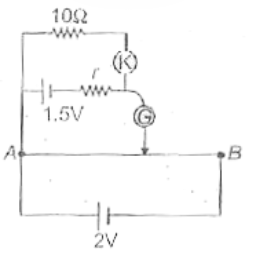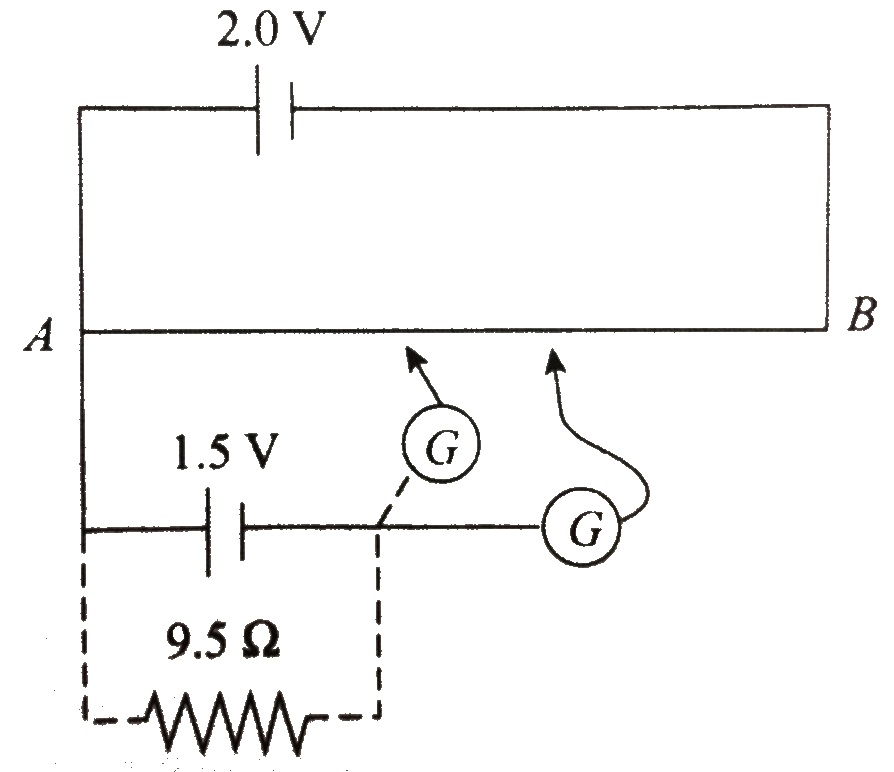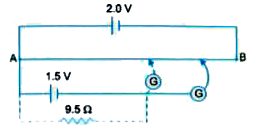Figure shows a 2.0V potentiometer used for the determination of internal resistance of a 1.5V cell , When the key is not inserted in the plug , the balance point is at 60 cm and in the closed circuit the balance point is at 50 cm. Find the internal resistance of the cell .

E2E1=l2l1
or E2=l2l1E1=5030×1.5V=2.5V
Topper's Solved these Questions
- CURRENT ELECTRICITYBOOK - AAKASH INSTITUTECHAPTER - CURRENT ELECTRICITYEXERCISE - Try Yourself
32 Videos
- CURRENT ELECTRICITYBOOK - AAKASH INSTITUTECHAPTER - CURRENT ELECTRICITYEXERCISE - ASSIGNMENT(SECTION-A(OBJECTIVE TYPE QUESTIONS))
59 Videos
- COMMUNICATION SYSTEMS BOOK - AAKASH INSTITUTECHAPTER - COMMUNICATION SYSTEMS EXERCISE - ASSIGNMENT SECTION D (Assertion-Reason)
10 Videos
- DUAL NATURE OF RADIATION AND MATTER BOOK - AAKASH INSTITUTECHAPTER - DUAL NATURE OF RADIATION AND MATTER EXERCISE - ASSIGNMENT (SECTION-D)
10 Videos
Similar Questions
Consider the potentiometer circuit for determining the internal resistance of a cell. When switch S is open, the balance point is found to be at 75cm os the wire. When switch S is closed and value of R is 4Ω, the balance points shifts to 60cm. find the internal resistance of cell.
 .
.
View SolutionFigure 6.13 shows a 2.0V potentiometer used for the determination of internal resistance of a 1.5V cell. The balance point of the cell in open circuit is 76.3cm. Whan a resistor of 9.5Ω is used in the external circuit of the cell, the balance point shifts to 64.8cm, length of the potentiometer. Dentermine the internal resistance of the cell.

View Solution
Knowledge Check
A 2.0V potentiometer is used to determine the internal resistance ofa I.SY cell. The balance point of the cell in the open circuit is obtained at 75cm. When· a resistor of 10Ω is connected across the cell, the balance point shifts to 60cm. The internal resistance of the cell is:
A1.5ΩB2.5ΩC3.5ΩD4.5ΩA 2.0 V potentiometer is used to determine the internal resistance of 1.5V cell. The balance point of the cell in the circuit is 75cm. When a resistor of 10Ω is connected across cel, the balance point sifts to 60cm. The internal resistance of the cell is
A1.5ΩB2.5ΩC3.5ΩD4.5Ω
A potentiometer is being used to determine the internal resistance of a primary cell. The balance point for the cell in an open circuit is at 76.3 cm. when the cell sends a current in a resistor of 9.5Ω, the balance point shifts to 64.8cm. Find the internal resistance of the cell.
View SolutionIn an experiment with a potentiometer to measure the internal resistance of a cell. when the cell in the secondary circuit is by shounted by 5Ω, the null point is at 220cm. When the cell is shunted by 20Ω the null point is at 300cm. Find the internal resistance of the cell.
View SolutionFig. shows a 2.0 V potentiometer used for the determination of internal resistance of a 1.5 V cell. The balance point of the cell in open circuit is 76.3 cm. When a resistor of 9.5Ω is used in the external circuit of the cell, the balance point shifts to 64.8 cm length of the potentiometer wire. Determine the internal resistance of the cell.

View SolutionIn an experiment with a potentiometer to measure the internal resistance of a cell, when the secondary circuit is shunted by 5Ω, the null point is at 220 cm. when the cell is shunted by 20Ω, the null point is at 300 cm. calculate the internal resistance of the cell.
View SolutionIn a potentiometer arrangement for determining the emf of a cell, the balance point of the cell in open circuit is 350 cm. When a resistance of 9Ω is used in the external circuit of the cell, the balance point shifts to 300 cm. Determine the internal resistance of the cell.
View SolutionIn a potentiometer arrangement for determining the emf of cell, the balance point of the cell in open circuit is 350 cm. When a resistance of 9Ω is used in the external circuit of cell , the balance point shifts to 300 cm. Determine the internal resistance of the cell.
View Solution
